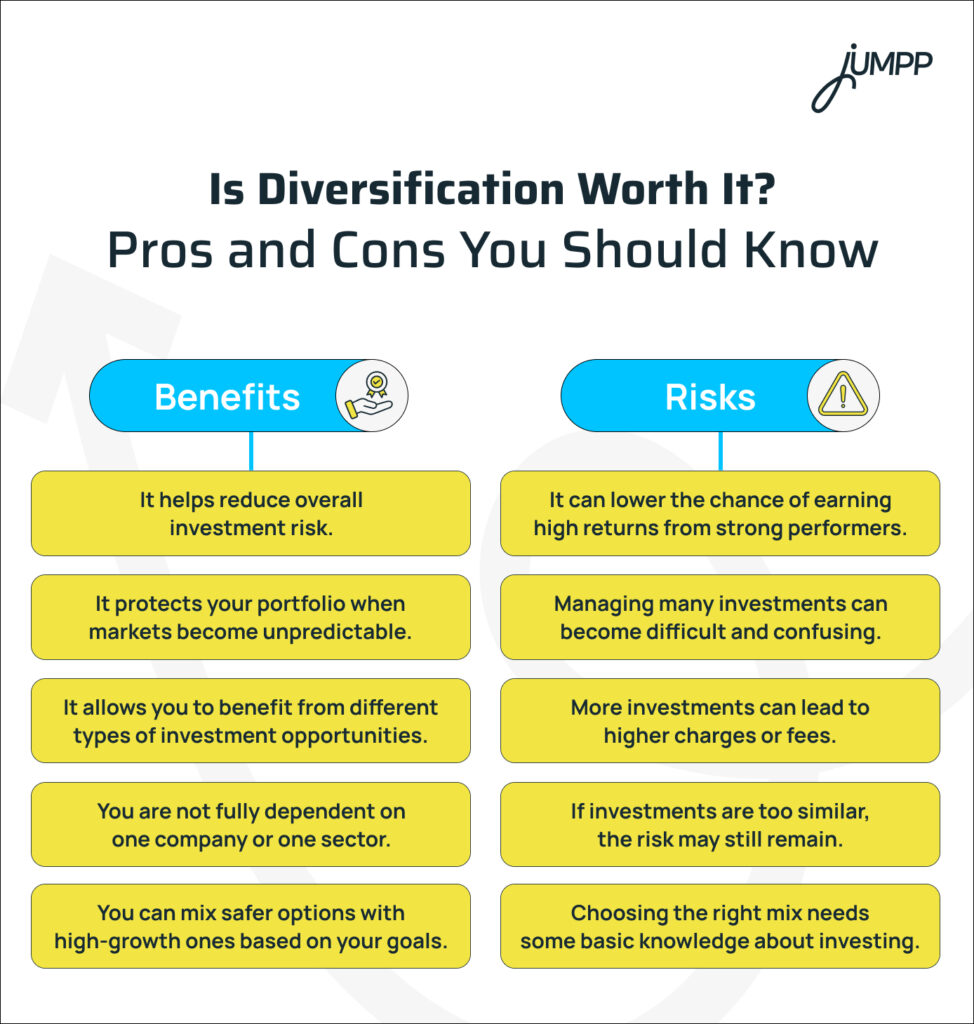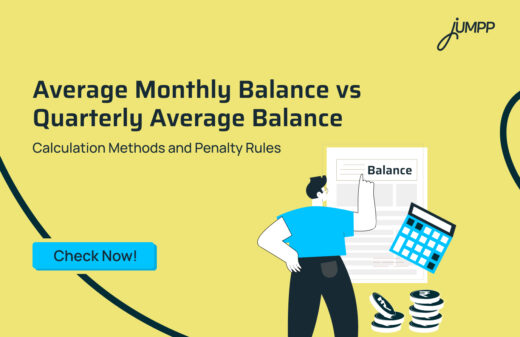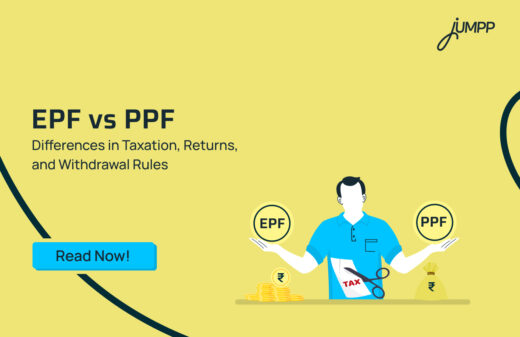What is Diversification in Investing: Meaning, Types, and Benefits

Diversification is one of the most important rules in investing. It means not putting all your money into one type of investment. Instead, you take a leap forward and spread it across different assets, industries, geographies, and even investment styles.
The goal is simple. You have to reduce risk without giving up the chance to earn constant returns.
Let’s learn the basics of investment diversification!
What is Diversification?
In simple terms, diversification is a strategy where you invest in a mix of different financial instruments. It can be across stocks, bonds, mutual funds, real estate, gold, or even foreign markets.
When one investment performs poorly, others may still do well. This helps you balance the overall risk of your portfolio.
Let us understand the diversification meaning with a simple diversified portfolio example.
A diversified portfolio example might include a mix like this:
- 40% in large-cap equity mutual funds
- 20% in mid-cap or small-cap stocks
- 20% in debt instruments like short-term bonds
- 10% in gold or commodity ETFs
- 10% in international funds or global ETFs
This kind of allocation ensures your money isn’t tied to just one asset or region. If one area underperforms, the others may hold or grow, helping you manage overall risk.
Want to build a truly diversified portfolio? Use an all-in-one investment app to Invest in stocks, bonds, mutual funds, ETFs, and more with a free demat account!
Why is Portfolio Diversification Important?
A diversified portfolio protects you from the sharp ups and downs of markets. It reduces unsystematic risk, which is specific to companies or sectors.
However, diversification cannot eliminate systematic risk. By this, we mean events such as inflation, wars, or global slowdowns.
But various types of diversification strategy can ease the impact by balancing assets that react differently in such times.
- If tech stocks fall, FMCG or healthcare stocks may still hold steady.
- If equity markets drop, gold or government bonds might rise.
This balance ensures you’re never fully exposed to just one kind of shock.
Types of Diversification in Investing
Let’s look at some ways you can diversify your investments.
1. Asset Class Diversification
This means investing across
- Equity (stocks or equity mutual funds)
- Debt (fixed deposits, bonds, debt funds)
- Commodities (gold, silver, oil)
- Real estate
- International markets
Each asset behaves differently. A fall in one class doesn’t affect the others in the same way.
2. Sector and Industry Diversification
Even within equities, you shouldn’t invest only in one sector. For example:
- Tech may do well in a digital boom.
- Pharma may benefit during a healthcare crisis.
- Banks may benefit when interest rates fall.
A mix reduces the impact of sector-specific risks.
3. Geographic Diversification
Investing globally helps reduce your dependence on the Indian economy. Foreign mutual funds, international ETFs, or stocks listed abroad give access to developed and emerging markets.
Events that affect India may not affect the US or Japan the same way, and vice versa.
4. Market Cap Diversification
Invest in companies of different sizes:
- Large-cap stocks are stable but grow more slowly.
- Mid-cap stocks carry more risk but can grow faster.
- Small-cap stocks offer high potential but also higher volatility.
Mixing them brings balance.
5. Risk Profile-Based Diversification of Risk
Every asset comes with a different risk level. Within bonds, for example:
- Government securities are safer.
- Corporate bonds offer more return but more risk.
Your portfolio should reflect your comfort with volatility.
6. Maturity Length Diversification
In fixed-income investments, mix short-term and long-term bonds:
- Short-term bonds give quick liquidity with less risk.
- Long-term bonds offer higher returns but also react more to interest rate changes.
This adds flexibility to your portfolio.
7. Tangible vs. Intangible Assets
- Stocks, bonds, and mutual funds are intangible. They exist on paper or digitally.
- Gold, property, and farmland are tangible. They have a physical presence.
Tangible assets behave differently and sometimes hold value better in crises.
One of the key benefits of diversification is that it helps reduce risk.
By spreading your investments across different assets, you avoid relying on just one performer. If one area dips, others can help balance it out.
But there’s a downside too.
Too much diversification can lower your returns and make your portfolio harder to manage.
Is Diversification Worth It? Pros and Cons You Should Know

Diversification in Mutual Funds
Mutual funds are one of the most accessible ways to diversify, but not all mutual funds are truly diversified. And not every combination of funds creates a well-balanced portfolio.
What is Mutual Fund Diversification?
Mutual fund diversification means investing across different categories of funds to spread your exposure. You diversify across:
- Risk levels (equity, debt, hybrid)
- Market capitalisations (large, mid, small)
- Geographies (domestic, international)
- Sectors (banking, pharma, IT, infra)
This helps reduce the risk of loss if one market segment underperforms.
Let’s say you invest in:
- A large-cap equity fund
- A mid-cap fund
- A short-term debt fund
- A gold fund
- An international ETF-based fund
Each of these behaves differently. They respond to different economic triggers. This means your overall returns aren’t tied to the fate of just one sector or market.
How Does Mutual Fund Diversification Work?
Many mutual funds are internally diversified. For example, a large-cap fund may hold shares in 50 to 100 companies across various sectors, such as FMCG, technology, energy, or banking. So even if one stock fails, others can keep the fund stable.
But here’s one important thing: not all funds offer true diversification.
- A sectoral fund may invest only in one industry (say, pharma). High reward, high risk.
- A small-cap fund may be concentrated in high-growth, high-volatility stocks.
- Some hybrid funds may lean heavily toward equity or debt depending on the market view.
So, it’s not just about choosing a mutual fund. It’s about choosing the right mix of funds that match your goals and risk tolerance.
Step-by-Step Diversification Strategy Using Mutual Funds
To diversify your mutual fund portfolio effectively, follow these practical steps:
Step 1: Know Your Risk Appetite
Are you okay seeing your investments go down 10% in a rough month? Or do you want low volatility even if it means lower returns?
- If you’re conservative: Go for short-term debt funds, gold funds, or large-cap funds.
- If you’re moderate: Blend large-cap, mid-cap, and hybrid funds.
- If you’re aggressive: Add small-cap and international equity funds for growth.
Step 2: Match Risk with Financial Goals
- For short-term goals (1–3 years): Use debt funds, liquid funds, or ultra-short-term bond funds.
- For mid-term goals (3–5 years): Use balanced advantage funds, short-term debt funds, and gold.
- For long-term goals (5–10+ years): Use equity funds with a mix of large, mid, and flexi-cap categories.
Don’t pick aggressive funds for short-term goals. This is because equity takes time to deliver.
Step 3: Avoid Overlap
Too many funds from the same category create redundancy, not diversification.
If you already have two large-cap funds, adding a third won’t add value. Instead, choose something uncorrelated, like an international fund or a debt instrument.
Want to diversify smarter? Explore the key differences in our savings vs investment guide.
Common Mistakes in Mutual Fund Diversification
- Owning too many funds: Beyond 5–7 funds, most portfolios get messy and repetitive.
- Choosing similar fund styles: Many people invest in different AMCs, but all in large-cap schemes. That’s duplication, not diversification.
- Ignoring correlation: If all your funds behave the same way in a downturn, you’re not really diversified.
The Thin Line Between Diversification and Over-Diversification
It’s tempting to keep adding new funds, thinking it’ll reduce risk. But too much diversification can:
- Dilute your returns
- Increase the monitoring burden
- Confused allocation strategy
The goal is not to hold “everything.” It’s to hold the right mix for your goals and risk level.
Diversification Meaning: FAQs
Diversification means spreading your investments or resources across different areas. It helps reduce the impact if one of them performs badly.
In business, diversification means entering new products, services, or markets. The goal is to reduce dependence on just one source of revenue.
It is the practice of dividing money or effort across different options to lower overall risk. This applies to both investing and business.
Diversification can help reduce risk, but it might also lower returns. Whether it works depends on how it’s done and for what goal.
It reduces portfolio risk, brings stable returns, and gives exposure to new opportunities. Diversification also protects during market swings.
It can dilute gains, increase tracking difficulty, and reduce focus. Too much diversification may also raise hidden costs.






